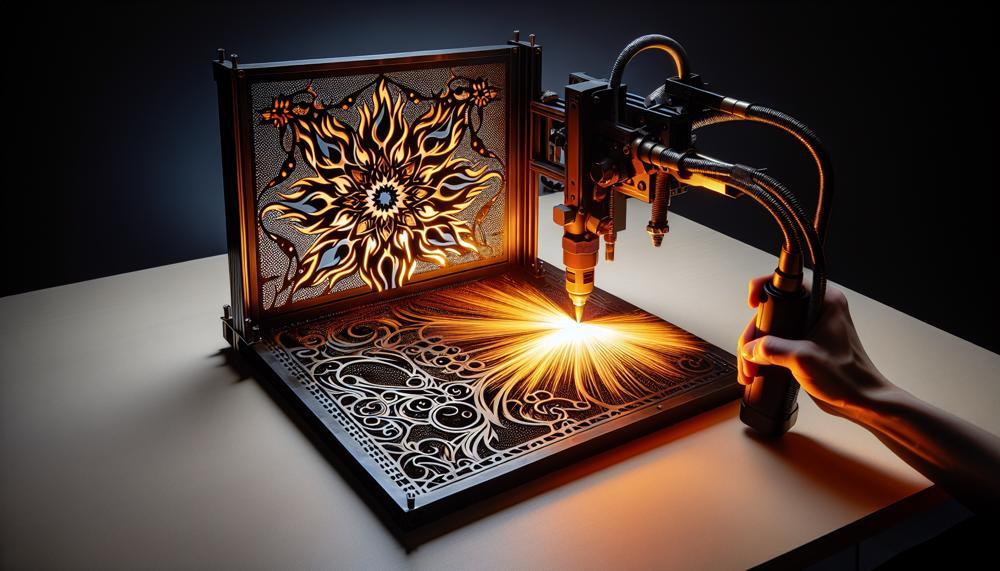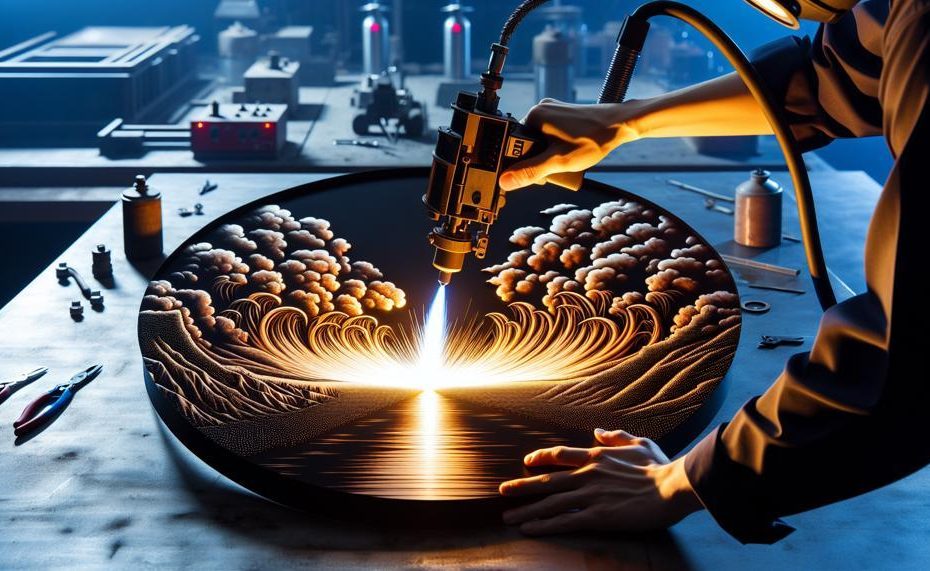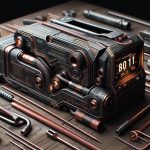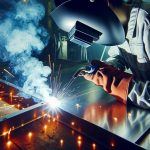Are you considering using plasma cutting for your next project? While this technology is widely used in various industries for its precision and speed, it also has its drawbacks that can impact its efficiency.
As a professional, it’s crucial to understand the disadvantages of plasma cutting to make informed decisions when choosing the right cutting method.
Let’s take a closer look at some key points to consider:
- Initial cost: The equipment and machinery required for plasma cutting can be quite expensive, making it a significant investment that may not be feasible for smaller businesses or projects.
- Limited thickness range: Although effective for thinner materials, plasma cutting may struggle with thicker materials, limiting its versatility.
- Hazardous fumes: Plasma cutting produces toxic fumes and gases that can be harmful if proper ventilation measures are not in place.
- Frequent consumable replacement: Consumable parts such as electrodes and nozzles need to be replaced frequently, adding to the overall cost of plasma cutting.
- Potential for warping: The high heat used in plasma cutting can cause warping or distortion in certain materials, affecting the accuracy of the final product.
While these challenges may seem daunting, proper training and precautions can help mitigate them. It’s essential to carefully weigh both the advantages and disadvantages before deciding on the best cutting method for your project.
In this article, we will delve deeper into each of these points to provide you with a comprehensive understanding of the potential downsides of plasma cutting.
Contents
The Science Behind Plasma Cutters
Plasma cutting is a widely used process in metal fabrication that involves creating an electric arc between an electrode and the workpiece, which is the material being cut. This arc is then forced through a small orifice in the cutting nozzle, where it comes into contact with a gas, such as nitrogen or argon.
The gas is then ionized and forms plasma, a highly reactive state of matter that can reach temperatures as high as 30,000 degrees Fahrenheit.
The plasma cutter utilizes this superheated plasma to melt through the metal at the point of contact, while simultaneously blowing away the molten metal for a clean cut. It also uses an electrical current to maintain the arc and control its intensity.
However, as with any welding method, there are potential downsides and limitations to consider. One of the major drawbacks is the production of toxic fumes that require proper ventilation and protective gear for the user’s safety.
Additionally, specialized equipment and training are necessary for plasma cutting, making it more expensive compared to other methods. The process can also leave behind messy residue (dross) that needs to be cleaned up after each cut.
Furthermore, plasma cutting has its limitations when it comes to materials and thicknesses it can effectively cut. It is not suitable for non-conductive materials or heavy-duty welding projects. Additionally, the quality of cuts may not be as high as other methods like laser or water cutting.
Advantages of Plasma Cutting
- Versatile Cutting: The primary advantage of using plasma cutting over other methods is its versatility. It can effortlessly cut through a wide range of materials, including tough metals that are challenging to cut with traditional techniques.
- Rapid Results: Plasma cutting is also renowned for its speed, making it the top choice for projects with tight deadlines. Compared to traditional methods, the process is significantly faster, saving both time and effort.
- Precise Accuracy: With its ability to create intricate shapes and lines with utmost precision, plasma cutting is highly accurate. This makes it a popular option for projects in construction, art, and metal fabrication that require high levels of precision.
- Cost-Effective Solution: Plasma cutting generates less waste and results in fewer on-the-job injuries, making it a more cost-effective option for end-users. It also requires minimal cleanup and maintenance compared to other methods.
- Enhanced Safety: In comparison to other cutting methods, plasma cutting is relatively safer as it uses gas that is not highly flammable. This makes it an ideal choice for single-person use with proper training.
- Thick Material Capacity: Plasma cutting can handle thicker pieces of metal (up to half an inch) compared to other options available in the market. This makes it a preferred choice for heavy-duty projects.
- Energy-Saving Process: Plasma cutting is an energy-efficient and sustainable method compared to traditional metal cutting techniques. It utilizes compressed air and an electrical arc to melt the metal, resulting in lower energy consumption.
Disadvantages of Plasma Cutting
Plasma cutting, although an immensely efficient and versatile welding technique, does have its share of drawbacks that need to be taken into consideration before use.
These include the initial expenses for equipment, restrictions in thickness and material suitability, safety concerns, and the need for skilled operators.
However, with proper utilization and maintenance, these downsides can be mitigated, and the benefits of plasma cutting can far outweigh any potential disadvantages. Let’s delve deeper into these drawbacks for a better understanding.
Initial Costs:
Purchasing and maintaining plasma cutting equipment can be quite expensive, making it less feasible for small-scale welding projects or those on a budget.
Moreover, specialized training may be necessary to operate the equipment effectively, adding to the overall cost.
Limitations in Thickness and Material Suitability:
Plasma cutting is most suitable for conductive metals such as steel and aluminum. It may not be as effective on non-conductive materials like wood or plastic.
Additionally, it is limited in its ability to cut through thick materials, making it less suitable for heavy-duty projects.
Safety Concerns:
Like any welding technique, plasma cutting poses safety hazards that should be taken seriously.
These include the risk of electric shock from the high voltage involved and exposure to harmful fumes produced during the cutting process.
Skilled Operators:
Plasma cutting requires skilled operators who are well-versed with the intricacies of the technique to ensure precise cuts and safe operation.
Without proper training and experience, achieving quality results may prove to be challenging.
Noise and Toxic Fumes:
Plasma cutting generates loud noise and toxic fumes that can pose health risks if not adequately ventilated or if protective gear is not worn.
This can add to the overall cost of using this technique.
Despite these potential downsides, plasma cutting remains a popular choice due to its speed, precision, versatility, and long-term cost-effectiveness.
Applications of Plasma Cutting
Plasma cutting is a popular choice for metal fabrication projects due to its balance of precision and speed.
While it may not offer the same level of accuracy as laser cutting or waterjet cutting, it is much faster and more cost-effective. Laser cutting is highly accurate but is slower and more expensive, making it better suited for intricate projects.
Waterjet cutting is versatile but also slower and more expensive compared to plasma cutting. Oxy-fuel cutting is commonly used for thick carbon steel materials, but it lacks the precision and speed of plasma cutting.
Despite these drawbacks, plasma cutting remains a preferred option for various metal fabrication applications.
| Cutting Method | Precision | Speed |
| Plasma Cutting | Average | Fast |
| Laser Cutting | Superb | Slow |
| Waterjet Cutting | Superb | Slow |
| Oxy-fuel Cutting | Moderate | Normal |
In terms of precision, laser cutting offers the highest level of accuracy among all cutting methods, producing clean edges and minimal distortion. However, this comes at the cost of speed and higher equipment expenses. Waterjet cutting also provides exceptional precision but is slower and more expensive than plasma cutting.
Plasma cutting offers good precision, with an average deviation of 0.005 inches, making it suitable for most metal fabrication projects. It also has a faster cutting speed compared to laser cutting and waterjet cutting, allowing for quicker project completion. Additionally, plasma cutting can handle a wide range of materials and thicknesses, making it a versatile option for various applications.
When it comes to cost-effectiveness, plasma cutting is the most budget-friendly option among all cutting methods. The equipment and operating costs are relatively low, making it accessible to small and medium-sized businesses. Laser cutting and waterjet cutting require more expensive equipment and have higher operating costs, while oxy-fuel cutting may be more cost-effective for thicker carbon steel materials.
Types of Plasma Cutters
There are three primary categories of plasma cutters: high-frequency contact, pilot arc, and touch start.
Each type has its own unique advantages and disadvantages, making them suitable for different applications.
High-Frequency Contact Plasma Cutters:
This type of plasma cutter utilizes a high-frequency circuit to ionize the air between the electrode and nozzle, creating an electric arc that can cut through workpieces.
While these cutters are typically more affordable, they are limited in their precision and can only be used on conductive materials.
However, they are still a great option for rough cutting and can handle materials up to 6 inches thick.
Advantages:
- Cost-effective initial investment
- Can cut through thicker materials
- Suitable for rough cutting
Disadvantages:
- Limited precision
- Only suitable for conductive materials
- Not ideal for intricate designs
Pilot Arc Plasma Cutters:
Pilot arc plasma cutters use a high-voltage, low-current circuit to create a small pilot arc between the electrode and nozzle. This arc then ionizes the air between the electrode and workpiece, resulting in a larger cutting arc.
These cutters offer greater versatility compared to high-frequency contact cutters and can achieve more precise cuts on thicker materials.
Advantages:
- More versatile than other types
- Provides better precision
- Can cut through thicker materials
Disadvantages:
- Higher initial cost than high-frequency contact cutters
- Limited range of materials and thicknesses
- Not suitable for heavy-duty projects
Touch Start Plasma Cutters:
Touch start plasma cutters use a low-voltage, high-current circuit to create an initial spark between the electrode and workpiece. This spark then ionizes the air between the electrode and nozzle, producing an electric arc that can cut through materials. These cutters are known for their exceptional precision and ability to cut through non-conductive materials.
Advantages:
- Highest level of precision
- Can cut through non-conductive materials
- Suitable for intricate designs
Disadvantages:
- Higher initial cost than other types of plasma cutters
- Limited range of materials and thicknesses
- Not suitable for heavy-duty projects
Plasma Cutting Safety Measures
Plasma cutting requires careful attention to safety measures to prevent accidents and injuries. Keep yourself and others safe by following these precautions:
Proper Grounding of Equipment

Ensuring that the plasma cutter is connected to a properly grounded outlet and that all cables and connections are in good condition is essential to prevent electric shock and fire hazards.
Wear Appropriate Clothing and PPE
The intense heat, sparks, and UV radiation produced during plasma cutting can cause burns and eye damage.
Protect yourself by wearing dry, flame-resistant clothing and gloves. Eye protection is also crucial, with a minimum shade level of 4 recommended for plasma cutting.
Keep a Fire Extinguisher On Hand
Given the potential for sparks and molten metal, it’s important to have a fire extinguisher nearby in case of any accidents.
Work in a Secure Area
Plasma cutting produces sparks that can travel a significant distance, so it’s important to work in a secure area away from flammable materials or objects.
Proper Ventilation
Fumes are produced when cutting metal with a plasma cutter, which can be harmful if inhaled. Ensure proper ventilation in the work area, especially when working with coated metals.
Use Appropriate Equipment for the Workload
To ensure safety while plasma cutting, always use equipment that is suitable for the job at hand. Using equipment that is too small or not designed for the task can lead to accidents and injuries.
Perform Routine Safety Checks
Before each use, perform routine safety checks on the equipment to ensure everything is in proper working condition. This includes checking cables, connections, and the machine itself.
Use Personal Protective Equipment (PPE)
In addition to appropriate clothing, use PPE such as welding helmets, respirators, and fume extractors to protect against electrocution, fire, and fumes.
| Equipment | Safety Measure | Reason |
| Plasma Cutter | Proper grounding | Prevents electric shock and fire hazards |
| Wear appropriate clothing and PPE | Protects against burns and eye damage | |
| Keep a fire extinguisher on hand | To handle any potential fires caused by sparks or hot metal | |
| Work in a secure area away from flammable materials or objects | To avoid potential fires from sparks and hot metal | |
| Ensure proper ventilation in the work area | To prevent inhalation of harmful fumes, especially when working with coated metals. |
Maintenance of Plasma Cutting Equipment
Plasma cutting equipment requires regular maintenance to ensure peak performance and prevent expensive downtime.
Operators should perform monthly, weekly, and daily checks to inspect, clean, and replace components as needed. It is also crucial to properly train operators and have a standardized maintenance checklist in place.
In case of breakdowns, it is recommended to seek expert help from companies like Esprit Automation for repairs.
Below is a table outlining the essential steps and recommended frequency for maintaining plasma cutting equipment:
| Frequency | Maintenance Steps |
| Monthly | Clean and align components such as the torch, nozzle, electrode, and retaining cap. |
| Monthly | Ensure the machine’s software is up-to-date and resolve any issues through necessary updates or repairs. |
| Weekly | Inspect hoses, fittings, and connections for leaks and wear. Replace damaged parts as needed. |
| Weekly | Verify the power supply is functioning properly. |
| Daily | Test gas flow and ensure it falls within the recommended range for the specific cutting application. |
| Daily | Check the torch for any damage or wear and replace worn out parts. |
| As Needed | Train operators on proper machine operation and maintenance procedures. |
Choosing the Right Plasma Cutting System
When selecting the right plasma cutting system, there are several key factors to take into consideration. These include the power source, cutting speed, material thickness, consumables, cost, maintenance requirements, safety features, and reputation/reviews.
By carefully considering these factors, you can mitigate some of the challenges that come with plasma cutting and ensure a smooth and effective cutting process.
Additionally, regular maintenance of your equipment is crucial to avoiding expensive downtime. Don’t hesitate to seek expert help when needed to keep your system running at its best.
In terms of power source, there are typically two options for plasma cutting systems: air or gas. Air-based systems tend to be more affordable and easier to maintain, while gas-based systems offer higher cutting speeds and precision. When it comes to cutting speed, it’s important to strike the right balance between speed and quality. Cutting too quickly can lead to rough edges and poor cuts, while cutting too slowly can result in wasted time and resources.
Material thickness is another crucial factor to consider. Different systems may have varying capabilities when it comes to cutting through thicker materials. Be sure to choose a system that aligns with your specific needs in terms of material thickness.
Consumables are also an important consideration as they can affect the overall cost and efficiency of your plasma cutting process. Make sure to regularly replace worn or damaged consumables to maintain optimal performance.
In terms of cost, it’s important to think beyond just the initial purchase price. Consider long-term maintenance costs, as well as potential savings from increased efficiency and productivity.
Finally, don’t overlook safety features and reputation/reviews when choosing a plasma cutting system. Ensuring the safety of operators should be a top priority, and seeking out reputable brands with positive reviews can help ensure you’re making a sound investment.
Also Read: What Do I Need To Be A Coded Welder?
Conclusion
In conclusion, while plasma cutting offers a multitude of benefits in metal fabrication, it also has its fair share of downsides.
These include initial costs, limited thickness range, hazardous fumes, frequent consumable replacement, and potential for warping. However, with proper training and precautions, these challenges can be overcome.
As a professional in the industry, it is crucial to consider both the advantages and disadvantages of plasma cutting in order to make informed decisions when selecting a cutting method for your project.
While plasma cutting may have its drawbacks like any other welding technique, it remains a popular choice due to its efficiency and versatility.
By thoroughly understanding both its benefits and limitations before use and taking necessary precautions during operation, you can harness the full potential of plasma cutting technology in your next project.





